MDC Monaco Auction N°9 Rare Coins and Medals
On June 3rd and 4th, an auction of collector’s coins and medals will take place in Monaco.
On June 3rd and 4th, an auction of collector’s coins and medals will take place in Monaco. Indeed, 1267 lots from Antiquity to today will be presented for all over the world. The sale will be conducted by the expert Nicolas Gimbert in the salons of ONE MONTE-CARLO.
Several remarkable sets will be presented:
- A beautiful selection of ancient coins, Greek and Roman, as well as a
collection of Gallic coins.
- For French coins, several great rarities will be offered for sale: a
Royal d’Or of Louis IX, a Franc à Cheval of Charles VII or an exceptional medallion of Louis XIII and Marie de Medici
in gold.
- Among the foreign coins, we note a nice set of Chinese coins, rarities
for Great Britain, Mexico, or Romania, etc...
- For Italy and Venice, we must note a collection of gold oselles
(multiples of gold offered directly by the doge), some of them struck in Murano, among the most beautiful known.
A prestigious 408-page catalog with numerous enlargements and historical comments will be available. LIVE participation will be possible on the BIDDR.CH platform.
PLACE DU CASINO
SALLE DES ARTS at ONE - MONTE CARLO
Expert : Nicolas Gimbert
Private exhibition :
1 - by appointment until June 2nd included at : MDC Monnaies de Collection
sarl
- 27 avenue de la Costa - 98000 Monaco
2 - Friday June 3 and Saturday June 4, 2022 from 8:30 am to 6:30 pm at: ONE Monte-Carlo Place du Casino - Monaco
MONNAIES DE COLLECTION sarl - 27 avenue de la Costa 98000 Monaco Monte-Carlo - 00377 93 25 00 42 - info@mdc.mc - www.mdc.mc

Lot 114.
Vitellius (69).
Aureus 69, Tarragona.
Obv. A VITELLIVS IMP GERMANICVS. Laureate head left.
Rev. LIBERTAS RESTITVTA. Liberty standing right with a spear and the
pileus.
RIC 9 (R2) - Calicó 564 ; Gold - 7,31 g - 19 mm - 6 h.
Provenance Schulman Vault Collection auction
NGC MS* 4/5 3/5 flan flaw. Slight planchet flaw on the cheek. Striking
and high relief portrait. Close to its mint state with its original
lustrous largely present. Mint State.
Price: 100000€
~
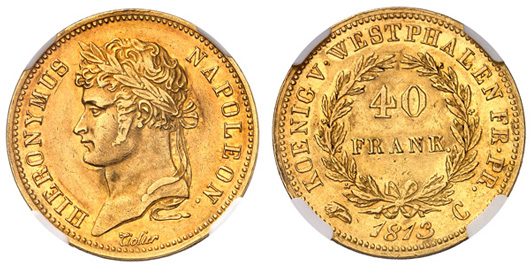
Lot 230.
Westphalia, Jérôme Napoléon (1807-1813).
40 frank 1813, C, Kassel.
Obv. HIERONYMUS NAPOLEON, Jérôme Napoléon’s Laureate head left, below
signature Tiolier.
Rev. KOENIG V. WESTPH. FR. PR./ (Mint Mark) (date) (Engraver Mark), Wreath
made of connected branches and leaves, in the center : 40 FRANK.
DMP.742 - Fr.3516 ; Gold - 13,10 g - 26 mm - 6 h.
Top Pop (2) : The finest graded !
NGC AU 55. Edge inscription. Extremely rare original mintage!
Heavyweight with over 13 grams. Coin alignment. small handling marks
and regular wear of the reliefs. Nice golden patina on the original
lustrous. About Uncirculated.
Price: 100000 €
~
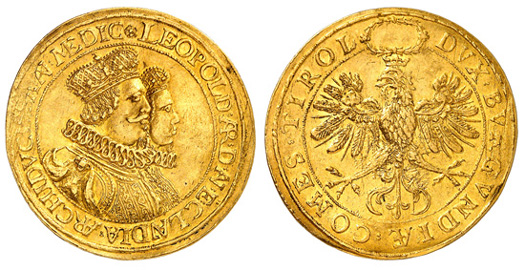
Lot 264.
Léopold Ier (1618–1632).
Module de 7 1/2 ducats, Léopold and Claudia of Médicis wedding ND (1626),
Hall.
Obv. * LEOPOLD. AR: D: AV. E. CLAVDIA. ARCHIDVCISA. AV. MEDIC. Busts
adjoined, crowned and cuirassed, right.
Rev. DVX. BVRGVNDIÆ. COMES. TIROL. Crowned and displayed eagle face-on,
under a crown.
Fr.180 (8 ducats) ; Gold - 25,91 g - 39 mm - 12 h.
Top Pop : this is the only coin graded ! Provenance Rudolf Scherer,
Wien, Münzen-Sammlung, oktober 1912 (von Morosini, Preis K550 ;
Achtducatenstück)
NGC AU 55. Utmostly rare. Extremely fine.
Price: 100000 €
~
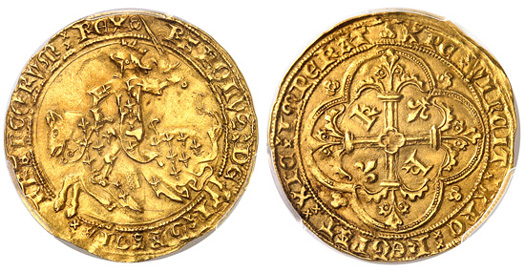
Lot 411.
Charles VII (1422-1461).
Franc à cheval ND (c.1424), Montpellier.
Obv. KAROLVS: D - EI: GRACIA: - FRACORVM: REX. King on horseback, galloping
to the left, sword raised, crowned with a helmet, wearing over his hauberk
a fleur-de-lys coat of arms; horse's caparison is fleur-de-lys.
Rev. (clover) XPC: VINCIT: XPC: REGNAT: XPC: IMPERAT. Cross with
fleur-de-lys and leafy with quatrefoil in heart, with a K in 1 and 4,
within a quatrefoil adorned with two lilies and with clovers.
Dy.451 - L.455 - Fr.302 ; Gold - 3,03 g - 27 mm - 4 h.
The second highest graded after the MDC 7 n° 225 (Toulouse). Provenance
the collection X.. (ex. reported by Lafaurie) then Künker auction 201,
February 2, 2012, N° 21
PCGS AU55. This is the last royal franc strucked! One of the greatest
rarities of French royal numismatics. Nice mintage fairly neat and well
centered. About uncirculated.
Price: 200000 €
The franc à cheval of Charles VII is known from only three examples, two for Toulouse and one for Montpellier. For Toulouse, one copy is kept in the Cabinet des Médailles of the Bibliothèque nationale de France; the second known copy was sold at MDC 7 auction n° 225. For Montpellier, the mintage is known by the mention of Lafaurie in 1951, coll. X.. probably the copy of the Künker auction in February 2012 and which is our copy, unique! The manufacture of Toulouse is attested by the Archives, while those of Montpellier are missing. For Toulouse, the franc à cheval was made between July 8 and August 21, 1424, with a value of 24 carats (1000 thousandths) and a weight of 80 pieces per marc, i.e. 3.059 g. Were used 56 marcs 2 ounces of fine gold (13,76 kg) to manufacture 4500 specimens, as the register of the National Archives Z1b 992 indicates: "C'est le compte d'une boueste de la Monnoye de Tholose de deniers d'or fin appelez frans à cheval qui ont cours pour XX sols tournois la pièce, à XXIIII caraz et à demi-carat de remède, de IIIIxx de poys au marc de Paris, fait en achat par Jehan de Veyrières pour lequel Jobert Vidal a tenu le compte du VIIIe jour de juillet inclus mil IIIIcXXIIII que la première délivrance fu faicte jusques au XXIIe jour d'aoust exclus ensuivant oud. an, en laquelle avoit XV deniers d'or qui font IIIImVc deniers d'or, poisent LVI mars II onces d'or". For Montpellier, the archives are missing. We also note, according to Jean Duplessy, that 200 copies were struck in Romans on July 1, 1424.
~
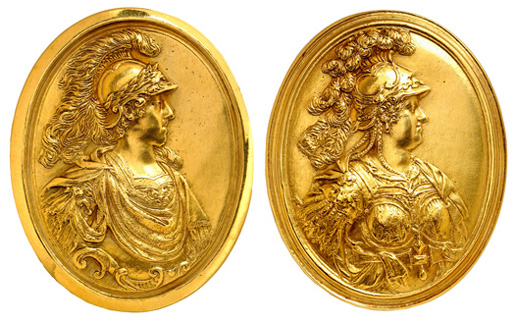
Lot 458.
Louis XIII (1610-1643).
Gold medallion or artistic medal, Louis XIII and Marie de’ Medici, assigned
to Guillaume Dupré, no date (1620-1622), Paris.
Obv. Bust of Louis XIII facing right, cuirassed, draped, wearing a plumed
parade helmet and laureated [as Mars], on a kind of finial.
Rev. Bust of Marie de’ Medici faceving right, cuirassed, draped, wearing a
plumed parade helmet [as Pallas-Athena or Minerva].
Maz.- - Rouyer cf. XXVII/1 = BnF Paris L.2562 (bronze) = RN, 1892,
p.491-496 = coll. P. Rattier (Rollin et Feuardent, 13th-14th april 1891, n°
71) = coll. B. Fillon (Rollin et Feuardent, 20th-24th march 1882, n° 165) -
RN, 1990, p.232-253 [L. Smolderen - À propos de Guillaume Dupré] ; Gold -
86,10 g - 46,2 x 57 mm - 12 h.
Very high quality cast, with high reliefs re-chiseled by the artist himself and polished fields. The obverse and reverse listels have been processed differently. Unique and, more than a medal, a true piece of art. Almost Uncirculated.
Price: 150000 €
This exceptional medallion (term we prefer compared to medal) is an unedited gold cast. This medallion is only known in bronze by the unique example of the Cabinet des médailles of the BnF in Paris, composed of two bronze plaques united in a brass frame with a bail. This bronze medallion of 47 x 58 mm, was acquired during the sale of Paul Rattier’s cabinet (Rollin et Feuardent, 13th-14th of april 1891, n°165) and was previously a part of Benjamin Fillon’s collection (Rollin et Feuardent, 20th-24th of march 1882, n°165). This bronze cast was represented in the Fillon’s collection sale catalogue [Rollin et Feuardent, 20th-24th of march 1882, n°165], in the Revue numismatique of 1892, p. 491-492 (etching) and also in Les médailleurs... by Natalis Rondot, pl. XXVII n°1.
According to Henri de la Tour, in the Revue numismatique of 1892, p. 491 to 496, the Cabinet des médailles bronze cast, “Italian inspired”, was made by a French or Italian artist and would have been created between 1618 and 1623 : “Careful comparisons with coins and medals leads us to the same conclusion : the effigy on this piece was surely not made before the one visible on the 1618’s pattern and, on the other hand, was not made after 1623, the king being beardless whereas, starting from 1623, the moustache starts appearing on the king’s portrait, clearly distinguishable on the good strikes of Dupré’s medal with Justice in reverse. We will point out that the physiognomy of Mari de’ Medici does not fit with the king’s one, the queen being rejuvenated and idealized, not showing the puffy figure visible on the contemporary portraits.”
Our example, like the bronze cast of the Cabinet des médailles, can be linked to another medal dated 1603, with no signature and still not found, only known by an intaglio made by the famous engraver Sébastien Leclerc (1637-1714), author of Médailles sur les principaux évènements du règne de Louis le Grand . This intaglio represents the bust of Marie de’ Medici facing left, wearing a helmet and cuirassed, with the legend A MIS ICI REMEDDE MDCIII (anagram of MARIE DE MEDICIS 1603) [S. Leclerc, Monnaies et médailles..., pl. VIII n°2].
On the same page, board VIII n°3, is our oval medallion representing Marie
de’ Medici.
Whereas Marie de’ Medici’s portrait might be idealized considering the age
of the Queen-mother, we think that the king’s one is pretty accurate. The
beardless face combined with his early middle age representation leads us
to think, like Henri de la Tour in the Revue numismatique of 1892,
that the engraving of the royal portrait has been realized in the 1620’s
and certainly before 1623.
There are very few events justifying the representation of a warrior king
and a Marie de’ Medici depicted as Pallas- Athena (or Minerva), goddess of
wisdom, intelligence and military strategy, but also symbol of Regency. Our
medallion has to be posterior to the Treaty of Angoulême (30th april 1619)
ending conflict between Louis XIII and his mother, consolidated on the 5th
of september 1619 by the public reconciliation of Tours. On the 24th of
December 1620, Protestants decide to take up arms after the La Rochelle’s
assembly. From 1620 to 1622, a military operation is carried out against
Protestants of La Rochelle. Our medallion could symbolize the common policy
adopted by the Queen-mother and her son to face the beginnings of the
protestant revolt of La Rochelle ? Louis XIII, as the war chief, and Marie
de’ Medici, as Pallas-Athena or Minerva, goddess of wisdom and military
strategy, could show the unity between the King and the Queen-mother facing
the protestant threat and fighting it together.
The artist of our unsigned medallion is unknown. Some careful comparisons with Italian medals of the second half of the XVIIth century made by Henri de la Tour in the Revue numismatique of 1892, p.495, demonstrate a clear transalpine influence. Rouyer quotes de la Tour in a comment about a medallion belonging to Jacob Richier and says “Fillon attributed it to a Frenchman, but was surprised that such an engraver could have stayed unknown. M. Henri de la Tour, without saying anything about the nationality of the author, thinks that it is –absolutely Italian inspired-“. Some elements allow us to name Guillaume Dupré as the author of the medallion : his travel in Italy in 1612, which has “singularly confirmed the Italianate and decorative tendencies of his style” (Smolderen, Revue numismatique 1990, p. 231), his close relations with Rubens, author of some paneling from the Cycle of Marie de’ Medici (1622-1625) in which the portrait of Marie de’ Medici as a triumphant queen links the two artists. But it’s mostly the engraving quality, the finish of the casting of which he was a renowned specialist and the high reliefs that lead us to Guillaume Dupré as the author. Note that Guillaume Dupré was a Huguenot and, as Smolderen writes : “It is allowed to ask ourselves if the Huguenot Guillaume Dupré could have agree to celebrate such actions against other Protestants.” However, that could explain why our medallion is unsigned.
Guillaume Dupré (1576-1643) is a sculptor since 1597, trained by his father-in-law Barthélémy Prieur. He becomes first King’s sculptor in June 1611, general controller of French coins’ hallmarks and effigies in October 1601 jointly with Jean Pillon, then alone in 1617. He is also general commissioner of artillery around 1629. His work is essentially composed of portraits ; some of his medals are uniface. He is a fantastic portraitist with a taste for opulent reliefs. Despite the event it seems to be connected with, our medallion is more than a medal, it is a piece of art worthy of the greatest
artists of his time. Let’s quote Rouyer one more time : “[this piece] is beautiful, made with finesse by a self-assured hand ; it is more of a jewel than a medal.”
Consulted works :
RONDOT (N.).- Les médailleurs et les graveurs de monnaies, jetons et
médailles en France.- Paris : E. Leroux, 1904. LA TOUR (H. DE).-
Médailles modernes récemment acquises par le Cabinet de France. VI/.
Louis XIII et Marie de Médicis.- Revue numismatique.- 1892.- p. 491-496,
fig. JOMBERT (Ch.-Ant.).- Catalogue raisonné de l’œuvre de Sébastien
Leclerc. Partie 1.- Paris : l’Auteur, 1774.
LECLERC (S.).- Monnaies et médailles relatives à l’histoire de France, de
Charles VII à Louis XIII.- Miscellany of XI boards, XVIIth siècle.
SMOLDEREN (L.).- À propos de Guillaume Dupré.- Revue numismatique.-
1990.- p. 232-253, pl. ee
MAZEROLLE (F.).- Les médailleurs français, du XV siècle au milieu du
XVII .- 3 volumes.- Paris : Imprimerie nationale, 1902-1904.
~
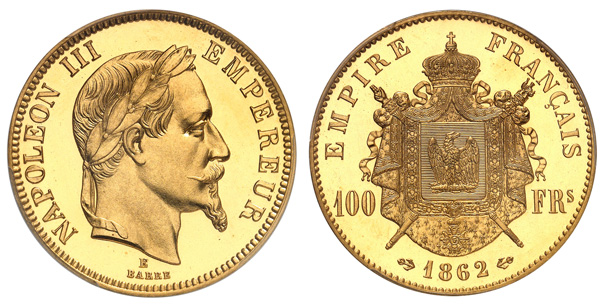
Lot 735.
Second Empire / Napoleon III (1852-1870).
Pattern 100 francs laureate head, special mintage 1862, E, Paris.
Obv. NAPOLEON III EMPEREUR. Laureate head right, below (Engraver Mark) and
signature BARRE.
Rev. EMPIRE FRANÇAIS (date). Value around the imperial arms on a crowned
mantle and broaching the sceptre and the hand of justice.
G.1136 - Maz.1603 - VG.3613 ; Gold - 32,18 g - 34,8 mm - 6 h.
Top Pop : The finest graded !
PCGS SP67. Special mintage with glazed mirror fields and sanded
reliefs, of an exceptional quality of presentation. Vintage between two
anchors on the reverse. Mint state. Perfect and very rare coin. Mint
State.
Price: 200000 €
~
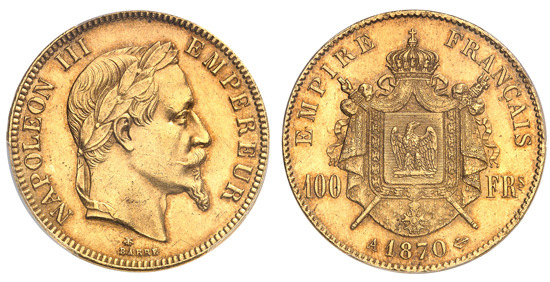
Lot 737.
Second Empire / Napoléon III (1852-1870).
100 francs laureate head 1870, A, Paris.
Obv. NAPOLEON III EMPEREUR. Laureate head right, below signature BARRE.
Rev. EMPIRE FRANÇAIS (date). Value around the imperial arms posed on a
crowned mantle and broaching on the scepter and the hand of justice.
G.1136 - F.551 - Fr.580 ; Gold - 32,25 g - 35 mm - 6 h.
Top Pop : The finest graded by PCGS !
PCGS MS62. Small flat on the ribbon end and high reliefs, with minimal
handling marks in the fields. Retains a nice color and the original
lustrous visible under a patina that has slightly browned the fields.
Utmosly rare. Mint State.
Only two copies engraved by PCGS, in AU55 and our copy in MS62 and four copies engraved by NGC, one in 53, one in 61 and two in 62. Our copy is certainly the most beautiful of the three copies engraved in 62.
Price: 250000 €
~
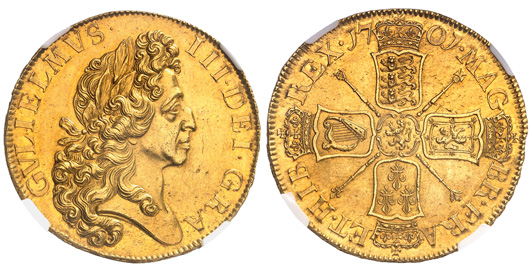
Lot 916.
Guillaume III (1694-1702).
5 guineas, 2nd bust 1701, London.
Obv. GVLIELMVS. III. DEI. GRA. Laureate bust on the right.
Rev. MAG. BR. FRA. ET. HIB. REX (date). Cross formed by four crowned
shields, with arms in heart, and canted by four scepters.
Fr.310 - S.3456 - KM.508 ; Gold - 41,66 g - 37 mm - 6 h.
NGC MS 62+. With bust with large wig and full scepters. The edge is
inscribed:
+ DECVS. ET. TVTAMEN. ANNO. REGNI. DECIMO. TERTIO +. This examplar has hardly circulated with the bust perfectly detailed on the right. Nice yellow-orange color. Mint State.
Price: 120000 €
~
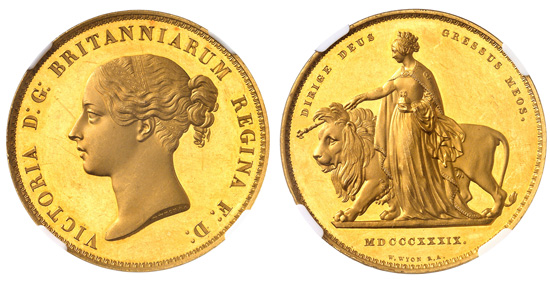
Lot 927.
Victoria (1837-1901).
5 pounds “Una and the lion”, Proof 1839, London.
Obv. VICTORIA D : G : BRITANNIARUM REGINA F : D : bust facing left, wearing
headband ; signature W . WYON R. A.
Rev. DIRIGE DEUS – GRESSUS MEOS. The queen facing left leading a lion with
her sceptre : (date) and signature W . WYON R. A. in exergue.
Fr.386 – S.3851 – W&R.278 – Schl.148 ; Gold – 38.52 g – 37 mm – 12h.
From the St James Auctions Ltd 11, 8th may 2009, n°244, then St James
Auctions Ltd 17, 24th may 2011, n°211.
NGC PF 62 ULTRA CAMEO. Proof. Edge : DECUS ET TUTAMEN ANNA REGNI
TERTIO. Minimal hairlines on the mirror surfaces with ultra cameo. Mint
State.
Price: 150000 €
Conceived by William Wyon (1795-1851) in 1839 to commemorate the beginning of queen Victoria’s reign (1837), the “Una and the lion” 5 pounds is considered one of the most beautiful british coins. Victoria, standing with a lion, is moving left, with the motto “May God direct my steps” above her. The young queen, 20 years old, is represented as Lady Una, from Edmund Spencer’s The Faerie Queene, a poem written in 1590. This is the first time a british monarch is represented as a fictitious character : England as a lion is guided by Una, personified by queen Victoria, and her sceptre.
~

Lot 1082.
Victor-Emmanuel II (1861-1878).
100 lire 1878, R, Rome.
Obv. VITTORIO EMANUELE II. Bare head facing left, signature FERRARIS and
(date) below.
Rev. REGNO D’ITALIA. In a two-branchs wreath, a crowned shield circled by
the Supreme Order of the Most Holy Annunciation’s collar, (mint) L.100
below.
Cud.1188c - P.453 - KM.19.2 - Fr.9 ; Gold - 32,25 g - 35 mm - 6 h.
Top Pop : this is the highest graded example ! From Varesi 71, 10th
November 2017, n°490.
PCGS MS65. Only 294 struck and this is the most beautiful known !
Gorgeous strike with slightly satin reliefs and mirror fields.
Uncirculated.
Price: 150000 €
~
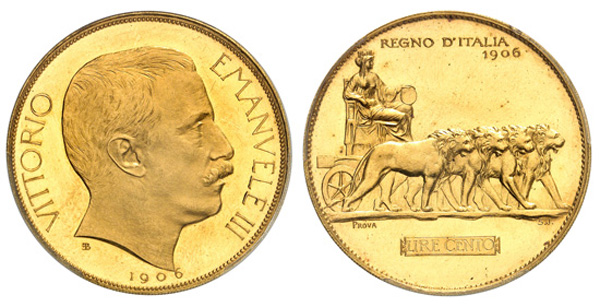
Lot 1091.
Victor-Emmanuel III (1900-1946).
Gold 100 lire pattern, the lion quadriga by S. Johnson, special strike
1906, Milano (Johnson).
Obv. VITTORIO EMANVELE III. Bare head facing right, signature EB and (date)
below.
Rv. REGNO D’ITALIA (date). Allegory of Italy as Cybele, stading in a
charriot pulled by four lions facing right. Below, a cartouche containing
LIRE CENTO ; PROVA to the left and signature S.J. to the right.
Pag.P- (cf.140) - Luppino PPSJ3 - KM.Pr4 ; Gold - 32,25 g - 35 mm - 6 h.
Top Pop : highest graded example !
PCGS SP64. Special strike with satin reliefs and mirror fields. Very
rare. Mint State.
Price: 100000 €
~
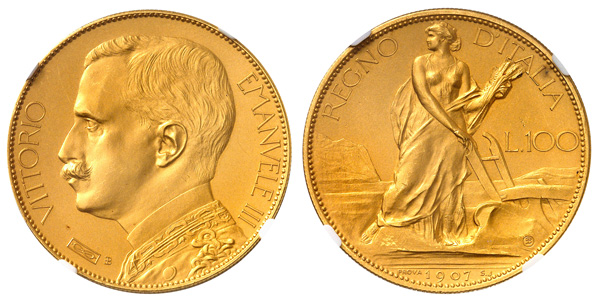
Lot 1093.
Victor-Emmanuel III (1900-1946).
Gold 100 lire pattern, the Agriculture by S. Johnson, Matte Proof 1907,
Milano (Johnson).
Obv. VITTORIO EMANVELE III. Bust in uniform, bare head facing left, Savoy
knot and signature EB in front.
Rev. REGNO D’ITALIA. Allegory of Italy standing to the right, head turned
backwards, holding a sheaf of ears and a plow, L.100 to the right ;
cartouche containing EB. PROVA (date) and S. J. in exergue.
Pag.P144 - Luppino PPSJ12 ; Gold - 32,48 g - 35 mm - 6 h.
Top Pop : highest graded example !
NGC PF 64 MATTE. Very rare. Mint State.
Price: 100000 €
~
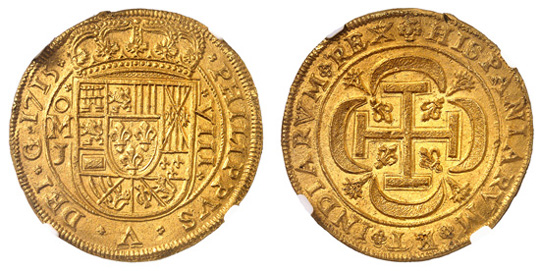
Lot 1110.
Philippe V (1700-1746).
“Royal” 8 escudos (special strike) from the Spanish silver fleet of 1715,
Mexico.
Obv. *PHILIPPVS* V* DEI* G* (date)*. Crowned arms of Castilla and Leon,
Catalonia, Aragon, Sicilia, Austria, Burgundy, Brabant, Flanders, Tyrol and
Bourbon, surrounded by *(mint) (assayer) and *VIII*
Rev. *HISPANIARVM* INDIARVM* REX. Cross potent, lilies in each angle
pointing to the center, in a quatrefoil surrounded by four tulips.
Aureo 2196 – Cal.291 – Cayon.9950 – Onza.401 – KM.R57.3 – Fr.7 ; Gold – 27
g – 35 mm – 12h.
This is the second highest graded by NGC, the first one graded MS66 and
this one MS62, coming from a Spanish silver fleet’s wreck of 1715.
NGC MS62 (Shipwreck certification). Big rosettes’ variety on the reverse. Letter J for José Eustaquio de Leòn, assayer. Very rare, with only 5 known examples and for a recently discovered date. Assay’s traces on the edge with minor marine corrosion on the surface (certified by NGC, coming from 1715 Fleet shipwreck). However, reliefs are specially processed in the die, giving a satin effect to this example, almost in mint state, never having circulated. Uncirculated.
Price: 250000 €
This coin is a “royal” 8 escudos, well-struck, on a prepared planchet, medal alignment, far above the quality of the “cob” 8 escudos quickly and poorly struck on irregular flans. Only 40 coins of the “royal” 8 escudos are known for twelve dates between 1680 and 1732 (1695, 1698, 1702, 1711, 1712, 1713, 1714, 1715, 1717, 1723, 1728 and 1723, and maybe 1718 but still non-confirmed). Our specimen is almost perfectly struck, only showing traces of a minimal double-struck, necessary to rise the reliefs of the coin during the manual strike. Due to similar making, the coins dated 1714 and after could have been struck using the screw press, a mechanical process that could explain the different aspect of those late coins. The few “royal” 8 escudos known, originally struck for the Royal Court of Spain and for dignitaries, are coming from recent submarine archeological discoveries of the 1715’s treasure of the Spanish fleet. On the 24th july 1715, an eleven ships fleet leaves Havana to go north-east, off Florida, before crossing the Atlantic, going to Spain with American treasures such as Peruvian and Columbian objects, precious stones, porcelain, silver and gold coins. Those treasures were sent to Spain to fill the financial pressing needs of the Spanish court. On the 31st july 1715, the ships encounter a hurricane killing 1500 officers and sailors whereas the shipment is scattered. Survivors inform authorities and a rescue mission is launched to help the shipwrecked and get the treasure back. For months, Spain recovers artefacts and millions of coins, even if pirates harass the operation. In 1718, the rescue mission is ended, considered as a success, even if lots of artefacts and coins are left undiscovered. They are retrieved at the end of the XXth and the beginning of the XXIth century, when 8 out of the 11 ships are recovered on the “treasure coast”. Sales are set up, after the State of Florida pre- empts 20% of the discoveries, since 1964. In 2015, 10 “royal” 8 escudos were retrieved, dated 1711 (7), 1712 (2) and 1715 (1). Those “royal” 8 escudos are considered as the most beautiful American colonial coins.
~
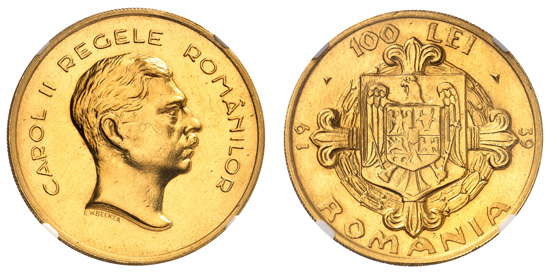
Lot 1152.
Carol II (1930-1940).
100 lei, centenary of Carol I birth, with large cupboards 1939, Bucharest.
Obv. CAROL II REGELE ROMÂNIOR. Head facing right, signature E. W. BECKER
below.
Rev. 100 LEI / ROMANIA. Four branchs cross adorned with lilies, on a crown,
a shield on top, and surrounded by (date).
KM.XM7 - Stamb.171 - Fr.13 ; Gold - 35 mm - 6 h.
Top Pop : highest graded example !
NGC MS 64. Very rare, remarkable quality, with original mint lustre. Most likely the most beautiful example known ! Uncirculated.
Price: 150000 €
~

Lot 1265.
Annam, Tu Duc (1848-1883).
Lang, gold strike, no date (1848-1883).
Obv. Around the central hole : Tu Duc thông bao, to the left ; Van thê
vinh lai, to the right ; the moon and the sun under clouds, above ; the
three mountains with longevity’s trees in the middle of the sea, below.
Rev. Written in chinese, a quatrain “The precious stone khuyet and the
cinnabar, in a thousand years, become pure gold, transmissible to ten
thousands generations. Thereby, we aknowledge the merit and we emphasise
the virtuous men, because only wisdom is precious.”
Schr.403 - KM.559 - Fr.32 v. ; Gold - 37,77 g - 65 mm - 12 h.
Top Pop : Highest graded example !
NGC MS 62. Very discrete double-strike on the obverse for this
impressive module ! Beautiful yellow with golden reflections.
Well-centered and good engraving. Very rare. Mint State.
Price: 120000 €

Download the Greysheet app for access to pricing, news, events and your subscriptions.
Subscribe Now.

Subscribe to CPG® Coin & Currency Market Review for the industry's most respected pricing and to read more articles just like this.
Source: M.D.C. Monaco


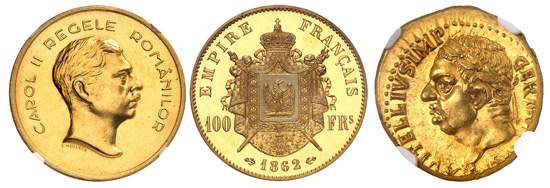






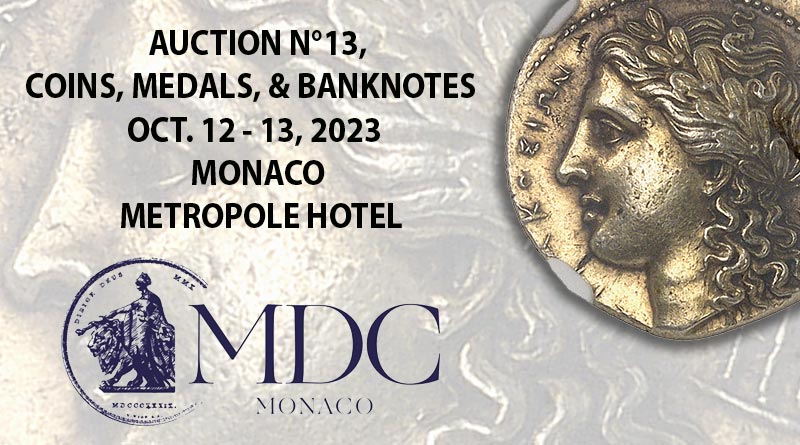
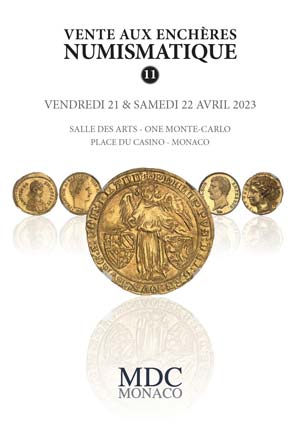
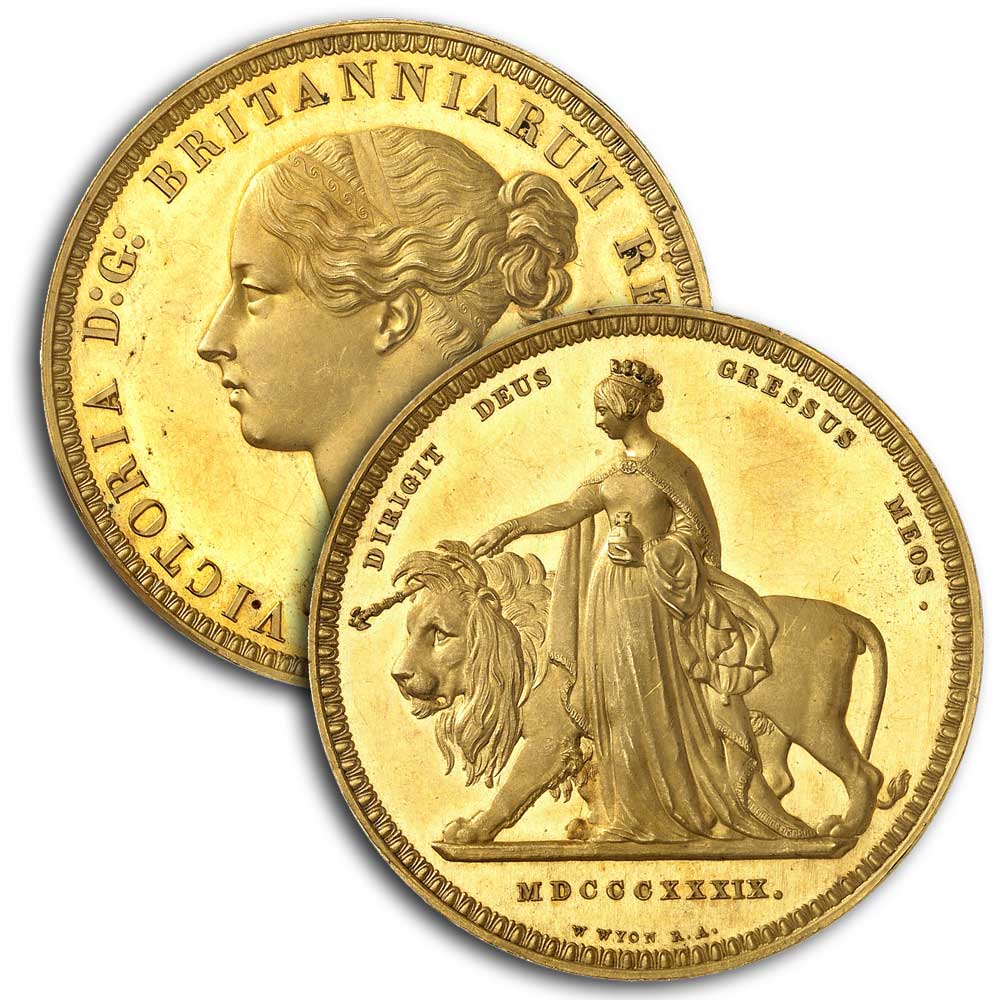
Please sign in or register to leave a comment.
Your identity will be restricted to first name/last initial, or a user ID you create.
Comment
Comments